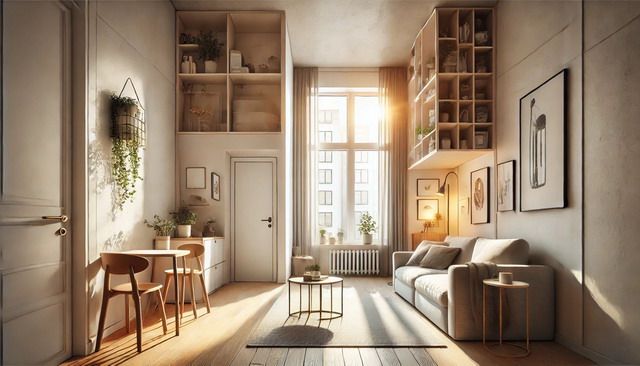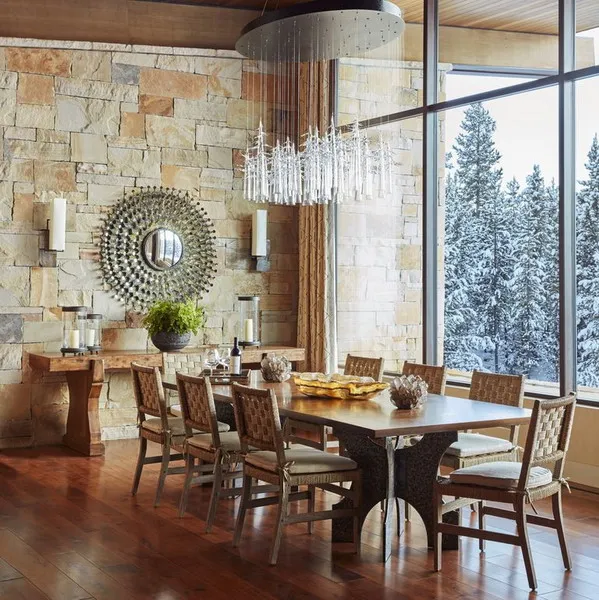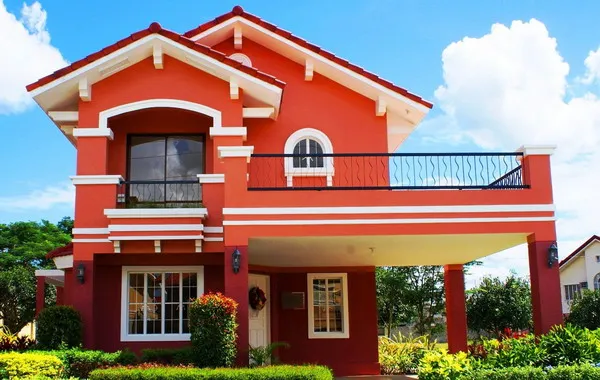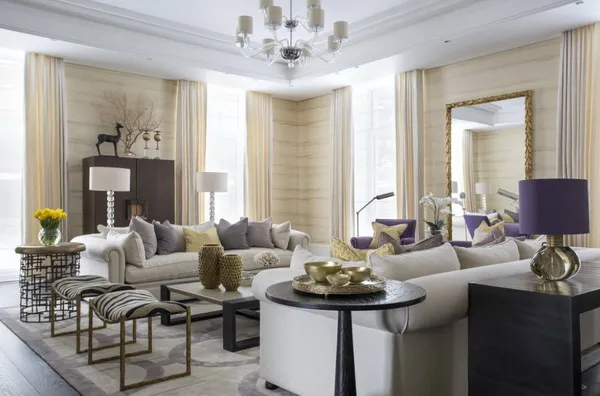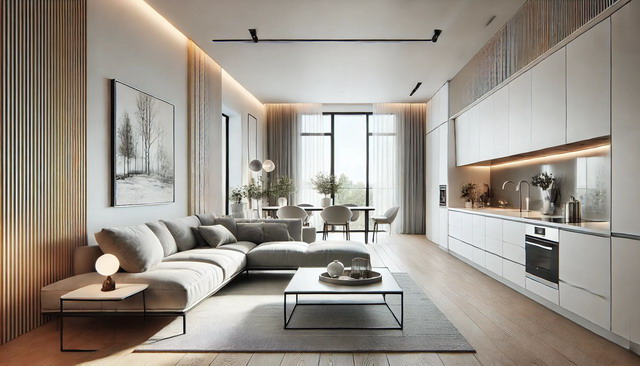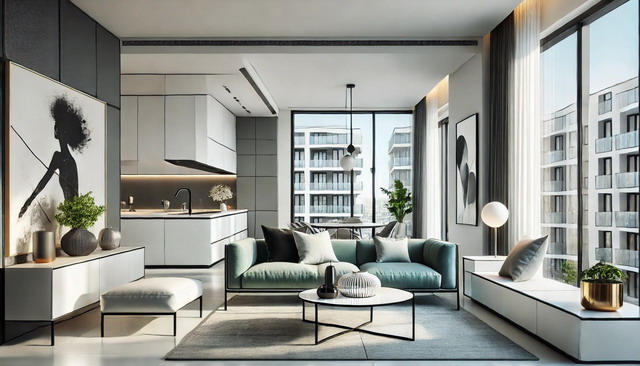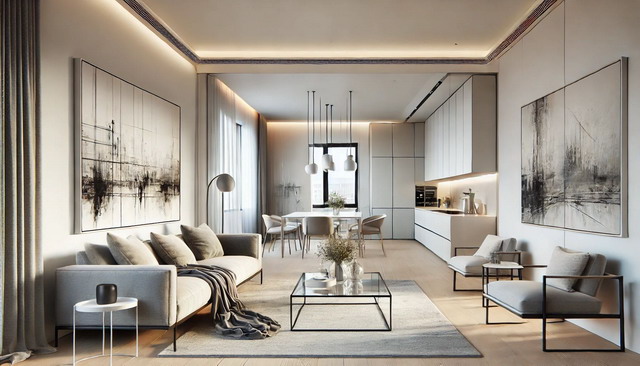Solutions for Lack of Natural Light in Small Apartments
Last Updated on August 26, 2024 by Mutiara
Living in a small apartment often means making the most of limited space, but one challenge that many residents face is the lack of natural light. Insufficient sunlight can make a small apartment feel even more cramped and gloomy, affecting both the atmosphere and your well-being. Natural light is not just a design preference; it plays a crucial role in enhancing mood, boosting energy levels, and creating an illusion of more space.
Unfortunately, many small apartments, particularly those in urban areas, struggle with poor lighting due to limited window space or unfavorable building orientation. In this post, we’ll explore the impact of inadequate natural light on small living spaces and share practical solutions to brighten your apartment, making it feel more open, airy, and inviting.
1. Introduction: Why Natural Light is Essential for Small Apartments
In the modern urban landscape, where high-rise buildings dominate and living spaces shrink, small apartments have become the norm for many. While these compact homes offer a cozy, efficient lifestyle, they often come with one significant drawback: a lack of natural light. The importance of natural light in any living space cannot be overstated, particularly in small apartments where every ray of sunlight can make a substantial difference in the feel and functionality of the home.
Natural light is more than just a design preference—it’s a crucial element that impacts everything from your physical health to your mental well-being. It enhances the aesthetic appeal of a space, making it feel larger, more open, and inviting. In small apartments, where space is already limited, the absence of natural light can make rooms feel cramped, gloomy, and uninviting. Without adequate sunlight, even the most carefully designed apartment can appear dull and lifeless, affecting not only the ambiance but also your mood and overall quality of life.
Understanding why natural light is so important, especially in small apartments, is the first step in addressing the challenges posed by its absence. Natural light plays a pivotal role in creating a sense of openness and airiness, essential qualities in small spaces. It brings out the true colors of your interior decor, highlighting textures and materials that artificial light often fails to capture. Furthermore, natural light has a profound impact on your circadian rhythms—the natural sleep-wake cycle that regulates many bodily functions. Without sufficient exposure to natural light, you might find your sleep patterns disrupted, leading to issues like fatigue, mood swings, and even depression.
Moreover, natural light is an energy-efficient way to illuminate your space. It reduces the need for artificial lighting during the day, helping you save on electricity bills and reducing your carbon footprint. In a time when sustainability is becoming increasingly important, maximizing natural light is a small but significant step toward a greener lifestyle.
However, the reality for many apartment dwellers is that natural light is often in short supply. Architectural constraints, building orientation, and surrounding structures can all contribute to a lack of sunlight in your home. Recognizing these challenges is crucial for finding effective solutions to brighten your living space.
In this article, we will explore the common challenges that cause poor natural light in small apartments and offer practical solutions to help you make the most of the available light. Whether you’re dealing with limited windows, obstructed views, or simply a less-than-ideal location, there are ways to enhance your apartment’s natural light and create a brighter, more welcoming environment.
2. Common Challenges: Identifying the Causes of Poor Natural Light in Small Apartments
For many apartment dwellers, the battle for natural light begins with the structural and environmental limitations of the building itself. Understanding the root causes of poor natural light in small apartments is essential to addressing the issue effectively. Let’s take a closer look at the common challenges that can diminish the amount of natural light in your living space.
Architectural Limitations
One of the primary reasons small apartments suffer from a lack of natural light is due to architectural design. Many apartment buildings, especially those in densely populated urban areas, are designed with efficiency in mind rather than maximizing sunlight. Narrow layouts, small or poorly positioned windows, and thick walls can all contribute to a darker living space.
- Window Size and Placement: Small or narrow windows are a common feature in many apartments, particularly those built in older buildings. These windows often do not allow enough light to penetrate deep into the space, leaving corners and interior rooms in perpetual shadow. The placement of windows also plays a crucial role; if windows are positioned too high or too low, they might not capture the full spectrum of available daylight, further reducing the light that enters the apartment.
- Building Depth: Apartments located in the interior of deep buildings often suffer from poor light because the sunlight only reaches the rooms closest to the outer walls. The further you move into the apartment, the darker it becomes, especially in hallways, kitchens, or bathrooms that might not have any windows at all.
- Low Ceilings: Low ceilings can exacerbate the problem of poor light in small apartments. Higher ceilings allow light to disperse more evenly throughout the space, creating a brighter atmosphere. Conversely, low ceilings can make the room feel more enclosed and dim.
Building Orientation and Surrounding Structures
The orientation of the building and the surrounding environment also play significant roles in determining the amount of natural light that reaches your apartment.
- North-Facing Apartments: Apartments that face north tend to receive less direct sunlight throughout the day, especially in the Northern Hemisphere. While this orientation provides consistent, indirect light, it often feels cooler and less bright compared to south-facing apartments that receive warm, direct sunlight.
- Obstructions: Surrounding buildings, trees, or even tall fences can block sunlight from entering your apartment. If your windows face a wall or another building just a few feet away, the amount of light that can filter into your space is significantly reduced. This is particularly common in urban settings where buildings are densely packed together.
- Floor Level: The floor level of your apartment can also affect natural light availability. Ground-floor apartments often have less light due to the proximity of surrounding structures and landscaping, whereas higher floors typically enjoy more unobstructed sunlight. However, if your apartment is on a higher floor but still faces an obstruction, such as a taller building, the benefit of height might be nullified.
Seasonal Variations
Natural light levels can also vary significantly with the changing seasons, especially in regions with pronounced seasonal shifts.
- Winter Months: During the winter, days are shorter, and the angle of the sun is lower, leading to less intense and shorter periods of daylight. Apartments that receive adequate light in the summer may feel much darker in the winter, compounding the challenges of small spaces.
- Overcast Weather: In regions prone to overcast weather or long rainy seasons, natural light can be significantly reduced, leaving even the most well-positioned apartments feeling dim and dreary.
Interior Layout and Design Choices
Sometimes, the way an apartment is furnished and decorated can contribute to the problem of poor natural light.
- Dark Interiors: Dark-colored walls, floors, and furniture can absorb light rather than reflecting it, making the space feel even darker. In small apartments, where every square foot counts, this can have a considerable impact on the overall ambiance.
- Obstructive Furniture: Large, bulky furniture placed near windows can block light from entering the room. Similarly, heavy curtains or blinds, if not properly managed, can limit the amount of daylight that penetrates the apartment.
Understanding these common challenges is the first step toward addressing the lack of natural light in your small apartment. While some factors, like building orientation or window size, are beyond your control, there are numerous strategies you can implement to maximize the available light and brighten your space. In the following sections, we’ll explore practical solutions and design tips to help you overcome these challenges and create a more luminous, inviting home environment.
3. Health Impacts: How Lack of Natural Light Affects Your Well-Being
The absence of natural light in small apartments is more than just an aesthetic concern—it can have profound effects on your health and well-being. Natural light plays a crucial role in regulating various bodily functions, including mood, sleep, and overall physical health. When your living space is deprived of sunlight, it can lead to a range of health issues that go beyond simply feeling a little down. Let’s explore how the lack of natural light impacts your mental and physical well-being.
The Link Between Natural Light and Mental Health
One of the most significant effects of insufficient natural light is its impact on mental health. Exposure to natural light is closely tied to the production of serotonin, a neurotransmitter that helps regulate mood. When your body is exposed to sunlight, it increases serotonin production, which can improve your mood and help you feel calm and focused.
- Seasonal Affective Disorder (SAD): One of the most well-documented conditions related to lack of sunlight is Seasonal Affective Disorder (SAD). SAD is a type of depression that typically occurs during the fall and winter months when daylight hours are shorter. Symptoms include feelings of sadness, low energy, irritability, and difficulty concentrating. For individuals living in small apartments with limited natural light, the risk of developing SAD can be even higher, as they may not get enough exposure to daylight even during the brighter months.
- General Mood and Well-Being: Even if you don’t experience full-blown SAD, living in a dimly lit apartment can still affect your mood. Natural light has been shown to increase feelings of happiness and well-being, while the absence of it can lead to feelings of gloominess or lethargy. Prolonged exposure to low light levels can contribute to chronic stress and anxiety, making it harder to cope with daily challenges.
Effects on Sleep Patterns and Circadian Rhythms
Natural light is a key regulator of your circadian rhythm, the internal clock that dictates your sleep-wake cycle. This rhythm is influenced by the light-dark cycle, with sunlight playing a vital role in signaling to your body when it’s time to be awake and when it’s time to sleep.
- Disrupted Sleep Patterns: A lack of exposure to natural light, especially in the morning, can disrupt your circadian rhythm, leading to irregular sleep patterns. Without adequate light, your body may struggle to produce enough melatonin, the hormone that promotes sleep. This can result in difficulty falling asleep at night, waking up frequently during the night, or feeling excessively tired during the day.
- Impact on Productivity: Poor sleep due to disrupted circadian rhythms can also affect your productivity and cognitive function. You may find it harder to concentrate, make decisions, or perform tasks efficiently. Over time, chronic sleep deprivation can contribute to more serious health issues, such as heart disease, obesity, and diabetes.
Physical Health: The Importance of Vitamin D
Natural light is also essential for physical health, particularly through its role in Vitamin D production. When your skin is exposed to sunlight, it synthesizes Vitamin D, a nutrient that is crucial for bone health, immune function, and overall well-being.
- Vitamin D Deficiency: Lack of sunlight can lead to Vitamin D deficiency, especially for those who spend most of their time indoors. Vitamin D deficiency is associated with a range of health problems, including weakened bones, increased risk of fractures, and a weakened immune system. In severe cases, it can lead to conditions like rickets in children and osteomalacia in adults.
- Immune System Support: Adequate Vitamin D levels are also important for maintaining a healthy immune system. Without enough sunlight, your body’s ability to fight off infections and illnesses may be compromised, making you more susceptible to colds, flu, and other infections.
The Role of Natural Light in Overall Health and Well-Being
In addition to the specific health issues mentioned above, natural light contributes to your overall sense of vitality and energy. Sunlight has a revitalizing effect, helping to regulate your body’s natural cycles and boosting your energy levels. Even just a few minutes of exposure to natural light each day can have a significant impact on your health and well-being.
- Energy and Motivation: Natural light helps regulate the release of cortisol, a hormone that plays a role in stress response and energy levels. Proper exposure to sunlight can help you feel more awake, alert, and motivated to tackle your day, while insufficient light can leave you feeling sluggish and unmotivated.
- Reduced Eye Strain: Working or living in dimly lit environments can also contribute to eye strain, particularly if you spend long hours staring at screens. Natural light is easier on the eyes than artificial lighting, reducing the risk of headaches, eye fatigue, and discomfort.
The lack of natural light in small apartments can have far-reaching effects on your mental and physical health. From mood disorders and disrupted sleep patterns to Vitamin D deficiency and reduced energy levels, the absence of sunlight can take a significant toll on your well-being. Recognizing these impacts is the first step in addressing the issue and finding ways to bring more light into your living space.
4. Lighting Solutions: How to Brighten a Small Apartment with Minimal Natural Light
Living in a small apartment with limited natural light can feel challenging, but there are plenty of strategies you can implement to brighten up your space. From maximizing the light you do have to incorporating artificial lighting solutions, these tips will help you create a more luminous and inviting environment, no matter how dim your apartment may be.
Using Mirrors to Reflect and Amplify Natural Light
Mirrors are one of the most effective tools for enhancing the light in any space. By strategically placing mirrors in your apartment, you can reflect natural light from windows and amplify it throughout the room, making your space feel brighter and more open.
- Position Mirrors Opposite Windows: The best way to maximize natural light with mirrors is to place them directly opposite or adjacent to windows. This setup allows the mirror to capture the incoming light and bounce it back into the room, effectively doubling the amount of sunlight that reaches your space.
- Create a Mirror Wall: For a dramatic effect, consider creating a mirror wall in a small, dark room. A large mirror or a collection of smaller mirrors can create the illusion of more space and reflect light throughout the room, making it feel brighter and more expansive.
- Mirrored Furniture and Décor: In addition to wall mirrors, incorporating mirrored furniture or décor items like mirrored trays, vases, or picture frames can also help reflect light and add a touch of glamour to your space.
Choosing the Right Artificial Lighting to Mimic Daylight
When natural light is scarce, artificial lighting becomes even more critical. Choosing the right types of lighting can make a significant difference in how bright and welcoming your apartment feels.
- LED Daylight Bulbs: Opt for LED bulbs that mimic natural daylight. These bulbs emit a bright, white light that closely resembles natural sunlight, making your space feel more vibrant. Look for bulbs with a color temperature of around 5000K to 6500K, which provides a clean, bright light that’s perfect for small, dimly lit spaces.
- Layered Lighting: Layered lighting involves using multiple light sources at different levels to create a well-lit environment. Combine overhead lighting with table lamps, floor lamps, and wall sconces to eliminate shadows and brighten every corner of your apartment.
- Smart Lighting: Consider using smart lighting solutions that allow you to adjust the brightness and color temperature of your lights throughout the day. This flexibility lets you create a warm, cozy atmosphere in the evening and a bright, energizing environment during the day.
Strategies for Optimizing Window Treatments to Maximize Available Light
Window treatments play a crucial role in controlling the amount of light that enters your apartment. Choosing the right materials and designs can help you make the most of the natural light available.
- Sheer Curtains: Replace heavy, dark curtains with sheer or semi-sheer curtains that allow light to filter through while still providing privacy. Light-colored or translucent fabrics will let in more light and make your apartment feel brighter.
- Avoid Heavy Drapes: If privacy isn’t a concern, consider skipping curtains altogether or using minimal window treatments like light-colored blinds or shades that can be fully opened during the day. This approach maximizes the amount of sunlight that enters your apartment.
- Reflective Window Films: Reflective window films can be applied to your windows to help reflect light into your apartment while also reducing glare and providing privacy. These films are an excellent option for apartments that face other buildings or have limited views.
Brightening a small apartment with minimal natural light is all about making the most of the light you do have and supplementing it with the right artificial lighting. By using mirrors, choosing the right bulbs, and optimizing your window treatments, you can transform a dark, cramped space into a bright, welcoming home. These strategies not only enhance the aesthetic appeal of your apartment but also contribute to your overall well-being, creating a living environment that feels comfortable and inviting.
5. Interior Design Tips: Creating a Bright and Airy Feel in Low-Light Apartments
When it comes to small apartments with limited natural light, thoughtful interior design can make all the difference. By strategically choosing colors, arranging furniture, and incorporating light-enhancing décor, you can create a space that feels bright, open, and welcoming, even if sunlight is scarce. Here are some interior design tips to help you maximize the light in your apartment and make the most of your living space.
Best Color Schemes for Small, Dark Spaces
Color is one of the most powerful tools in interior design, especially in spaces that lack natural light. The right color scheme can transform a dark, cramped apartment into a bright and airy retreat.
- Opt for Light, Neutral Colors: Light, neutral colors such as white, cream, light gray, and soft pastels reflect light rather than absorb it, making your space feel more open and inviting. These shades help to bounce light around the room, giving the illusion of a larger, brighter area.
- Avoid Dark and Saturated Hues: While dark colors can add drama and coziness to a space, they tend to absorb light, making the room feel smaller and darker. If you love dark tones, consider using them as accent colors rather than the main color in your palette.
- Use Glossy and Reflective Finishes: Paint your walls with a satin or semi-gloss finish rather than a matte one. Glossy finishes reflect more light, enhancing the brightness of the room. You can also incorporate glossy or reflective surfaces in your furniture and décor, such as glass tables, metallic accents, and mirrors, to further amplify the light.
- Monochromatic Color Schemes: A monochromatic color scheme—using varying shades of a single color—can create a cohesive and serene environment that feels more spacious. For example, different shades of white or beige can create a soft, inviting space that looks more expansive and less cluttered.
Furniture Placement to Make the Most of Limited Light
How you arrange your furniture can have a significant impact on the amount of light that reaches different areas of your apartment. Thoughtful furniture placement can help distribute light more evenly and prevent any one area from feeling too dark.
- Avoid Blocking Windows: Keep windows as unobstructed as possible. Large furniture items, such as sofas or bookcases, should be placed away from windows to ensure that light can flow freely into the room. Even lightweight furniture can block light if placed too close to windows, so try to keep these areas clear.
- Use Low-Profile Furniture: Low-profile furniture allows more light to pass over it, making the room feel less crowded and more open. Choose furniture with slim legs or a low back, which can help create a sense of space and allow light to move freely.
- Maximize Corners and Walls: Corners and walls can often be the darkest parts of a room. Placing reflective or light-colored furniture, like a glass console table or a light wood bookshelf, in these areas can help brighten them. Additionally, consider using corner floor lamps to add light where it’s most needed.
- Open-Plan Layouts: If possible, opt for an open-plan layout or create a sense of openness by using furniture that doesn’t obstruct the flow of light. For example, using a see-through bookshelf or a glass coffee table can help maintain an open, airy feel while still providing necessary storage and surface space.
Incorporating Light-Enhancing Décor
In addition to color and furniture placement, your choice of décor can significantly influence how light is distributed and perceived in your apartment. Here are some ideas for light-enhancing décor that can brighten your space:
- Mirrors and Reflective Surfaces: As mentioned earlier, mirrors are one of the most effective ways to amplify light in a small, dark apartment. Large wall mirrors, mirrored furniture, and décor with metallic finishes can all help reflect light and make the room feel more open.
- Glass and Acrylic Furniture: Transparent furniture, such as glass tables or acrylic chairs, doesn’t block light and can help the space feel less cluttered. These pieces create the illusion of more space and allow light to pass through, keeping the room bright.
- Light-Colored Textiles: Choose light-colored textiles for your curtains, rugs, and upholstery. Soft, pale fabrics help to reflect light, making the room feel brighter and more inviting. For added texture, consider materials like linen or cotton, which have a natural lightness to them.
- Strategic Use of Art: Artwork can either brighten or darken a room, depending on how it’s used. Opt for art pieces with light backgrounds or bright, vibrant colors to add a pop of brightness to your walls. Frame your art in light-colored or metallic frames to further enhance the light-reflecting effect.
- Layering Light Sources: Don’t rely on a single overhead light to illuminate your space. Instead, layer different types of lighting—ambient, task, and accent lighting—to create a well-lit, balanced environment. Table lamps, floor lamps, wall sconces, and under-cabinet lighting can all contribute to a brighter, more inviting space.
Creating a bright and airy feel in a low-light apartment is entirely possible with the right interior design strategies. By choosing a light color scheme, arranging furniture to maximize light flow, and incorporating reflective and light-enhancing décor, you can transform your small, dark space into a bright, welcoming home. These design tips not only improve the aesthetic appeal of your apartment but also enhance your overall living experience by making your environment feel more comfortable, open, and inviting.
6. Plants and Décor: How to Use Greenery and Accessories in Low-Light Apartments
Plants and décor can do more than just beautify your apartment—they can also play a significant role in enhancing the available light and making your space feel more vibrant and alive. However, when natural light is limited, it’s essential to choose plants and accessories that can thrive and complement the overall ambiance of your home. Here’s how to make the most of greenery and décor in a low-light apartment.
Choosing Houseplants That Thrive in Low-Light Conditions
Adding plants to your apartment brings a sense of nature indoors and can help purify the air, creating a healthier living environment. However, not all plants can thrive in low-light conditions. The key is to select species that are known for their ability to adapt to lower light levels.
- Snake Plant (Sansevieria): The snake plant is one of the most resilient houseplants, known for its ability to survive in various light conditions, including low light. Its tall, upright leaves add a modern touch to your décor, and it requires minimal maintenance.
- ZZ Plant (Zamioculcas zamiifolia): Another hardy option, the ZZ plant, is perfect for low-light apartments. Its glossy, dark green leaves can brighten up a dim corner, and it’s incredibly low-maintenance, tolerating infrequent watering and low light.
- Pothos (Epipremnum aureum): Pothos is a popular choice for its trailing vines and ability to thrive in low-light environments. It’s also known for its air-purifying qualities, making it a great addition to any room that needs a touch of greenery.
- Spider Plant (Chlorophytum comosum): Spider plants are easy to care for and can adapt to low light. Their arching, variegated leaves add visual interest, and they’re also effective at removing toxins from the air.
- Philodendron: Many varieties of philodendron are well-suited to low-light conditions. With their heart-shaped leaves and trailing growth habit, philodendrons can be placed on shelves or in hanging baskets to add greenery without taking up valuable floor space.
Using Reflective Surfaces and Light-Colored Accessories
In addition to plants, accessories can play a significant role in enhancing the light in your apartment. By choosing items that reflect light or are light-colored, you can brighten your space and create a more open feel.
- Reflective Planters: Choose planters with reflective surfaces, such as those made from polished metal or glass, to add both greenery and light-reflecting elements to your décor. These planters can help distribute light throughout the room while showcasing your plants.
- Light-Colored Pots: If reflective planters aren’t your style, opt for light-colored pots in white, cream, or pastel shades. These colors will help brighten your space and complement the light, neutral color scheme recommended for low-light apartments.
- Mirrored Trays and Décor: Incorporate mirrored trays, coasters, and decorative objects to add shine and reflect light. These items not only serve a practical purpose but also contribute to the overall brightness of your space.
- Textured Fabrics in Light Colors: Use cushions, throws, and rugs in light, textured fabrics to add warmth and softness to your apartment without darkening it. Textures like knitted blankets or woven rugs in soft colors can add depth and interest to your décor while maintaining a light, airy feel.
Creating a Cohesive Design That Compensates for Lack of Natural Light
When decorating a low-light apartment, it’s essential to create a cohesive design that works with the light you have rather than against it. This means carefully selecting and arranging your plants and accessories to enhance the available light and create a harmonious environment.
- Group Plants Strategically: Arrange your low-light plants in groups to create a mini indoor garden. By placing them near windows or reflective surfaces, you can make the most of the available light and create a focal point that draws the eye.
- Balance with Light-Colored Accessories: Use light-colored accessories to balance the darker tones of your plants and furniture. For example, a white or light-colored throw blanket on a dark sofa can help brighten the space, while light-colored picture frames can add contrast to a dark wall.
- Use Shelving to Elevate Plants: Place plants on shelves or hanging planters to lift them closer to the light source. This not only helps the plants thrive but also adds layers to your décor, making the room feel more dynamic and spacious.
- Incorporate Natural Materials: Natural materials like wood, rattan, and stone can add warmth and texture to your apartment while maintaining a light, organic feel. Consider using these materials for plant stands, shelves, or other decorative elements to create a cohesive, nature-inspired design.
Incorporating plants and accessories into your low-light apartment not only enhances the space aesthetically but also contributes to a brighter, more inviting environment. By choosing the right plants, using reflective surfaces, and carefully selecting light-colored accessories, you can create a cohesive design that compensates for the lack of natural light. These strategies will help you cultivate a living space that feels lively, fresh, and full of energy, even in the dimmest corners.
7. DIY Projects: Simple Ways to Improve Natural Light in Your Small Apartment
If you’re looking to brighten up your small apartment and maximize the natural light available, DIY projects can offer creative and cost-effective solutions. With a few tools and some ingenuity, you can enhance the light in your space, making it feel more open and inviting. Here are some DIY projects that can help you improve natural light in your small apartment.
Installing Skylights or Solar Tubes (Where Possible)
For those living on the top floor of a building or in a space with direct access to the roof, installing skylights or solar tubes can be a game-changer. These installations bring in natural light from above, flooding your apartment with daylight and significantly brightening the space.
- Skylights: Skylights are an excellent option for rooms that lack sufficient windows. They can be installed in ceilings to allow natural light to pour in from above. Skylights are particularly effective in areas like kitchens, bathrooms, and hallways, where wall space for windows might be limited. Modern skylights often come with options for UV protection and automated shading, giving you control over the amount of light and heat that enters your space.
- Solar Tubes: If installing a full skylight isn’t feasible, solar tubes (also known as light tubes or sun tunnels) offer a more accessible alternative. These tubes capture sunlight from the roof and channel it down into your apartment through reflective tubing. Solar tubes are smaller and less invasive to install than skylights, making them an ideal option for small spaces or rental apartments where larger structural changes aren’t allowed.
Adding Light Shelves or Reflective Window Films
If you’re dealing with limited windows, you can use light shelves or reflective window films to make the most of the sunlight that does enter your apartment.
- Light Shelves: A light shelf is a horizontal, reflective surface installed on the interior or exterior of a window. It works by reflecting sunlight deeper into the room, distributing light more evenly across the space. You can create a simple DIY light shelf by placing a wide, flat surface (such as a white-painted wooden shelf) directly beneath your window. Angle it slightly upwards to catch and reflect sunlight into the room.
- Reflective Window Films: Reflective window films are a great DIY solution for increasing natural light without making permanent changes to your apartment. These films can be applied directly to your windows to reflect more light into the room while also providing privacy and reducing glare. Look for films that offer a combination of light reflection and UV protection to maximize the benefits.
Creative DIY Hacks to Increase Perceived Light in a Small Space
In addition to structural changes, there are plenty of simple DIY hacks you can implement to increase the perceived light in your apartment. These projects are budget-friendly and can make a significant difference in how bright and open your space feels.
- Paint the Ceiling White: One of the easiest ways to brighten a room is by painting the ceiling white. A white ceiling reflects more light than a darker color, helping to distribute sunlight throughout the space. For an added effect, use a high-gloss or semi-gloss paint to enhance the reflective qualities.
- Install a Light-Reflecting Backsplash: In kitchens or bathrooms, consider installing a light-reflecting backsplash. Materials like glass tiles, stainless steel, or mirrored surfaces can bounce light around the room, making it feel brighter and more spacious. This project can be completed over a weekend and adds both function and style to your apartment.
- DIY Window Expansions: If you’re handy with tools and your lease permits minor renovations, you might consider expanding your windows’ trim to create the illusion of larger windows. By painting the trim in a light color and extending it beyond the window’s actual frame, you can trick the eye into thinking the windows are bigger, allowing more perceived light to enter the space.
- Use Light-Colored Curtains with Rods Extended Beyond the Window Frame: Hang your curtains on rods that extend beyond the window frame. This trick makes the window itself appear larger, allowing more light to flood into the room when the curtains are open. Choose light-colored, sheer curtains to let in as much natural light as possible, even when the curtains are drawn.
- Create a Faux Skylight: For a creative touch, you can create a faux skylight using LED panel lights. These flat, thin lights can be installed on the ceiling to mimic the appearance of a skylight, providing bright, even light that resembles natural daylight. You can even use a diffuser panel with a sky pattern to enhance the effect.
DIY projects are a fantastic way to take control of the light in your small apartment, allowing you to enhance natural light and create a more pleasant living environment. Whether you’re installing skylights, adding reflective surfaces, or making simple changes to your décor, these projects can have a big impact on how bright and inviting your space feels. With a bit of creativity and effort, you can transform even the darkest corners of your apartment into a light-filled oasis.
8. Psychological Strategies: How to Mentally Cope with Living in a Low-Light Apartment
Living in a small apartment with limited natural light can sometimes feel challenging, especially during the darker months of the year. The lack of sunlight can affect your mood, energy levels, and overall well-being. However, by adopting some psychological strategies and making small lifestyle adjustments, you can learn to cope with and even enjoy living in a low-light environment. Here’s how to maintain a positive mindset and maximize your well-being in a dimly lit space.
Adapting Your Daily Routine to Maximize Exposure to Natural Light
One of the most effective ways to combat the effects of low light is to ensure you get as much natural light as possible during the day. By adjusting your daily routine to include more exposure to daylight, you can help regulate your circadian rhythm and improve your mood.
- Morning Walks: Start your day with a morning walk, even if it’s just around the block. Morning sunlight is particularly beneficial for resetting your internal clock and boosting your mood for the day ahead. If you can, spend at least 20-30 minutes outside in the natural light each morning.
- Work Near a Window: If you work from home or spend a lot of time indoors, try to set up your workspace near a window to maximize your exposure to natural light. Even if the light isn’t direct, being close to a window can help you feel more connected to the outside world.
- Take Breaks Outside: Throughout the day, take short breaks to step outside and soak up some daylight. Whether it’s a quick walk during lunch or simply standing by an open window, these moments can help you feel more energized and improve your overall mood.
Using Light Therapy Lamps to Combat Seasonal Affective Disorder (SAD)
For those particularly sensitive to low light, especially during the winter months, light therapy lamps can be an effective tool to combat Seasonal Affective Disorder (SAD) and other mood-related issues.
- What is a Light Therapy Lamp? Light therapy lamps, also known as SAD lamps, mimic natural sunlight and are designed to help regulate your body’s circadian rhythm. These lamps emit a bright light (usually around 10,000 lux) that simulates daylight, helping to reduce symptoms of SAD and improve your mood.
- How to Use a Light Therapy Lamp: Place the lamp on your desk or a nearby table and use it for about 20-30 minutes each morning. It’s most effective when used early in the day, as this can help regulate your sleep-wake cycle. Make sure the light shines indirectly into your eyes (you don’t need to look directly at it) while you go about your morning routine.
- Choosing the Right Lamp: When selecting a light therapy lamp, look for one that offers full-spectrum light with a brightness of at least 10,000 lux. Some lamps also come with adjustable brightness settings and timers, allowing you to customize the experience to your needs.
Creating a Positive Mindset and Enjoying the Coziness of a Low-Light Space
While it’s natural to crave more light, it’s also important to embrace the unique atmosphere that a low-light apartment can offer. By shifting your perspective and focusing on the positive aspects, you can learn to appreciate and enjoy the cozy, intimate environment of your home.
- Create a Cozy Atmosphere: Lean into the natural ambiance of your low-light apartment by creating a cozy, comfortable environment. Use soft lighting, warm textiles, and natural materials to make your space feel inviting and relaxing. Think of your apartment as a retreat from the hustle and bustle of the outside world—a place where you can unwind and feel at peace.
- Practice Mindfulness: Mindfulness techniques can help you stay present and appreciate the here and now, even in a low-light environment. Focus on the things you love about your apartment—its warmth, the way light filters in during certain times of the day, the comfort of your favorite chair. Practicing gratitude for these small details can help shift your mindset and reduce feelings of discontent.
- Decorate with Intention: Surround yourself with items that bring you joy and make you feel good. Whether it’s artwork, books, or plants, fill your apartment with things that reflect your personality and create a space that feels uniquely yours. By focusing on what you can control—your décor and atmosphere—you can take ownership of your environment and create a space that supports your mental well-being.
- Stay Connected: Social connections are essential for mental health, especially when living in a low-light environment that might sometimes feel isolating. Make an effort to stay connected with friends and family, whether through regular visits, phone calls, or virtual meetups. Sharing your space with loved ones, even if it’s just for a short visit, can bring warmth and light into your home.
Living in a low-light apartment doesn’t have to be a negative experience. By adapting your routine to maximize natural light exposure, using tools like light therapy lamps, and cultivating a positive mindset, you can thrive in your space and make it a cozy, inviting haven. Remember, it’s all about perspective—by embracing the unique qualities of your home and making small adjustments, you can create a living environment that supports your well-being and brings you joy.
9. Conclusion: Embracing and Enhancing Your Small, Low-Light Apartment
Navigating the challenges of living in a small apartment with limited natural light can seem daunting at first, but with the right approach, you can transform your space into a bright, welcoming, and comfortable home. Throughout this article, we’ve explored various strategies to help you cope with and enhance the light in your apartment, from practical interior design tips to psychological strategies that improve your well-being.
Recap of Key Strategies
- Understanding the Importance of Natural Light: Recognize how natural light affects not only the aesthetic appeal of your space but also your physical and mental health. By understanding these impacts, you can take proactive steps to improve your environment.
- Overcoming Common Challenges: Identify the architectural and environmental factors that limit natural light in your apartment and implement design solutions such as using mirrors, optimizing window treatments, and choosing light-reflecting materials to brighten your space.
- Interior Design Tips: Create a bright and airy feel in your apartment by choosing the right color schemes, arranging furniture to maximize light flow, and incorporating light-enhancing décor elements like mirrors and reflective surfaces.
- Incorporating Plants and Accessories: Bring life into your low-light apartment by choosing houseplants that thrive in low-light conditions and using light-colored or reflective accessories to enhance the available light.
- DIY Projects: Explore creative DIY projects, such as installing light shelves, reflective window films, or faux skylights, to increase the natural light in your apartment and make it feel more open and inviting.
- Psychological Strategies: Adopt a positive mindset by making the most of the cozy atmosphere in your low-light apartment. Use light therapy lamps, embrace mindfulness, and create a space that reflects your personality and brings you comfort.
Embrace Your Space
Ultimately, the key to thriving in a small, low-light apartment is to embrace the space you have and make it your own. While natural light may be limited, there are countless ways to enhance your living environment and create a home that feels bright, welcoming, and uniquely yours.
Remember, your apartment is more than just a physical space—it’s where you relax, recharge, and live your daily life. By focusing on the aspects you can control and making thoughtful design choices, you can turn your low-light apartment into a place where you truly feel at home.
So, take the strategies and tips discussed in this article and start transforming your space today. Whether it’s adding a few reflective surfaces, incorporating cozy textiles, or simply rearranging your furniture, each small change can have a big impact on how your apartment looks and feels. Embrace the challenges, get creative, and enjoy the process of making your apartment a place that brings you light, warmth, and happiness.
